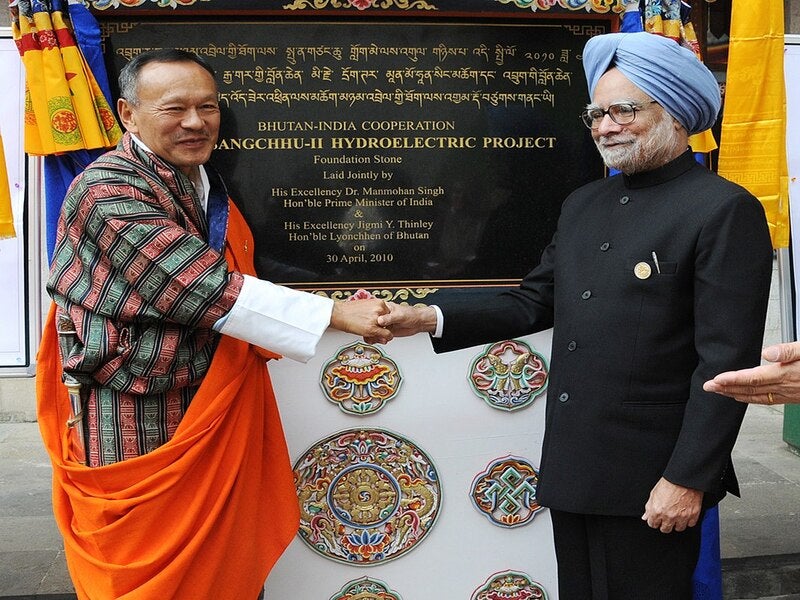The Punatsangchhu II is a 1GW run-of-the-river hydroelectric power generating facility under construction in the Wangdue Phodrang district of Bhutan.
The project is being developed by the Punatsangchhu II Hydroelectric Project Authority, under an Inter-Government Agreement (IGA) between the Royal Government of Bhutan and the Government of India.
The construction works on the £965m ($1.5bn) project were started in December 2010 with completion expected by the end of 2022.
Upon commissioning, the Punatsangchhu II power plant is expected to generate approximately 4,357 million units of electricity annually.
Location and site details
The Punatsangchhu II hydroelectric power project is located on the right bank of the Punatsangchhu River in the Wangdue Phodrang district in Western Bhutan.
The project site is spread along the Wangdue-Tsirang National Highway, downstream of the Punatsangchhu I hydroelectric power project which has been under construction since 2008.
Punatsangchhu II dam
The Punatsangchhu II hydroelectric power project involves the construction of a 91m-high and 223.8m-long concrete gravity dam, along with an 877.46m-long and 12m-diametre diversion tunnel with a discharge capacity of 1118 cubic metres per second.
The project also involves a 168.75m-long and 22m-high upper cofferdam and a 102.02m-long and 13.5m-tall downstream cofferdam.
The main dam will have seven sluice gates measuring 8m-wide and 13.20m- high each.
Punatsangchhu II hydroelectric power project make-up
The Punatsangchhu II hydroelectric power plant will comprise an underground powerhouse measuring 240.7m-long, 23m-wide and 51m-high. The powerhouse will be equipped with six Francis turbines of 170MW capacity each. The turbines will operate at a water head of approximately 236m.
The powerhouse will receive water flow through an 8.5km-long and 11m-diameter headrace tunnel (HRT) and three 5.5m-diameter steel-lined pressure shafts divided into six penstocks each 3.86m in diameter.
The project also includes a 2.87km-long and 10m-diameter tailrace tunnel (TRT), and a 137m high and 31m-diameter surge shaft.
The underground transformer cavern will accommodate 20 single-phase generator transformers of 13.8kV/400kV and 70MVA capacity.
Power evacuation
The electricity generated by the Punatsandchhu II hydroelectric power plant will be evacuated through a 400kV double circuit power transmission line.
Contractors involved
India’s state-owned engineering and manufacturing enterprise Bharat Heavy Electricals (BHEL) was contracted for the design, manufacturing, supply, erection, and commissioning of the electro-mechanical equipment and associated auxiliaries for the project in June 2012.
Jaiprakash Associates was awarded a contract worth approximately £164m ($268m) for the construction of a diversion tunnel, dam, water intake structure, and highway tunnel in June 2011. It is also responsible for the construction of a part of the HRT, pressure shafts, powerhouse and the TRT under another contract worth approximately £115m ($187m).
BAUER Spezialtiefbau was subcontracted by Jaiprakash Associates for permeation grouting works of the upstream cofferdam in March 2014.
Gammon India Construction Engineering Company has been engaged in the construction of the headrace tunnel.
Hyosung Corporation received an order for the delivery of the 420kV gas-insulated switchgear (GIS) in April 2013, while South Korean-based LS Cable is responsible for the supply of 400kV cross-linked polyethylene (XLPE) cables for the project.
Bhutan Automation and Engineering was contracted for the supply of computerised control and protection system in December 2018.
Encardio and Rite Geosystems was subcontracted for the supply, installation and commissioning of instruments in the powerhouse complex.
India-based Water and Power Consultancy Services (WAPCOS) provided engineering and design consultancy services during the project study phase, while the National Institute of Rock Mechanics (NIRM) was engaged for modelling and geotechnical engineering services.





